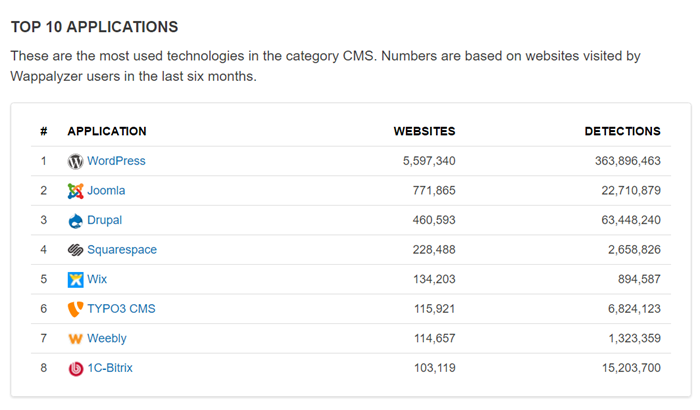Open Source Turns 20: Where It Sits in the CMS World
The “open source” concept was created at a strategy session held on February 3rd, 1998 in  Palo Alto, California. The world first heard about Open Source when an announcement of Open Source was published twenty years ago on February 9, following that session. Since then, the concept has been adopted in ways we couldn’t have expected to experience two decades ago and probably in more ways than we are aware of even today. We are all utilizing open source when we are watching our favorite TV show on Netflix, stalking people on Facebook and Instagram, or searching for something on Google to win a discussion with our friends. However, in honor of its 20th anniversary, we will go beyond those use cases as we look at how the open source movement began, how it has become the center of tech innovation, and where it now sits in the content management system world.
Palo Alto, California. The world first heard about Open Source when an announcement of Open Source was published twenty years ago on February 9, following that session. Since then, the concept has been adopted in ways we couldn’t have expected to experience two decades ago and probably in more ways than we are aware of even today. We are all utilizing open source when we are watching our favorite TV show on Netflix, stalking people on Facebook and Instagram, or searching for something on Google to win a discussion with our friends. However, in honor of its 20th anniversary, we will go beyond those use cases as we look at how the open source movement began, how it has become the center of tech innovation, and where it now sits in the content management system world.
A History of Open Source in Brief
Although this year technically marks the 20th anniversary of open source software, its roots stretch back into the late 70s when an MIT programmer Richard M. Stallman developed a free printer utility based on its source code. Shortly after his invention, the source code had become obsolete with the arrival of a new laser printer on the campus. His disappointment drove him to believe that he could no longer allow proprietary software to rule so he started the free software movement. However the concept, mostly because of the word “free”, was misunderstood and disdained. The idea of software being developed with no cost or payment came across simply as irrational but the reason why Stallman called it “free” was referring to liberty more than price as the main idea was developing application and system source code that was available and also including the software under a license which can enable user freedom.
Although the confusion around the term wasn’t the only roadblock at the time, fortunately, this misinterpretation would be taken care of by Christine Peterson, president of the Foresight Institute, when she coined the term “open source” at a strategy session which was held in inspiration of Netscape’s release of the source code of its Netscape Communicator web browser 20 years ago. Until then, companies’ typical practice was keeping source codes as the secret to favor intellectual property profiteers.
The strategy meeting was held by Eric S. Raymond, Michael Tiemann, Todd Anderson, Jon "maddog" Hall, Larry Augustin, Sam Ockman, and Christine Peterson. On February 5, 1998, Peterson announced the new term “open source,” and she has recently once again elaborated on that term:
"The introduction of the term 'open source software' was a deliberate effort to make this field of endeavor more understandable to newcomers and to business, which was viewed as necessary to its spread to a broader community of users. The problem with the main earlier label, "free software," was not its political connotations, but that -- to newcomers -- its seeming focus on price is distracting. A term was needed that focuses on the key issue of source code and that does not immediately confuse those new to the concept. The first term that came along at the right time and fulfilled these requirements was rapidly adopted: open source."
endeavor more understandable to newcomers and to business, which was viewed as necessary to its spread to a broader community of users. The problem with the main earlier label, "free software," was not its political connotations, but that -- to newcomers -- its seeming focus on price is distracting. A term was needed that focuses on the key issue of source code and that does not immediately confuse those new to the concept. The first term that came along at the right time and fulfilled these requirements was rapidly adopted: open source."
One of the founders of the open source movement, Bruce Perens, who had previously drafted the Debian Free Software Guidelines (which would be adapted to become the OSD), puts the date at February 9, 1998, when he published an announcement of the OSD. To further clarify what open source is and what it is not, Raymond and Perens founded the Open Source Initiatives (OSI).
All these announcements that took place 20 years ago changed not only how to call the movement but also its mission in the business world. The difference between Stallman’s purely ideological approach to making software freely available and the motivation of the Open Source Initiative, which is presenting open source as more commercially palatable to everyone, rather than an ideological and activist free software movement. Many still think that they are fundamentally the same things in a different voice and tone, while Stallman begs to differ:
“The two terms describe almost the same method/category of software, but they stand for  views based on fundamentally different values. Open source is a development methodology; free software is a social movement. For the free software movement, free software is an ethical imperative, essential respect for the users' freedom. By contrast, the philosophy of open source considers issues in terms of how to make software 'better' -- in a practical sense only. It says that non-free software is an inferior solution to the practical problem at hand. Most discussion of "open source" pays no attention to right and wrong, only to popularity and success.”
views based on fundamentally different values. Open source is a development methodology; free software is a social movement. For the free software movement, free software is an ethical imperative, essential respect for the users' freedom. By contrast, the philosophy of open source considers issues in terms of how to make software 'better' -- in a practical sense only. It says that non-free software is an inferior solution to the practical problem at hand. Most discussion of "open source" pays no attention to right and wrong, only to popularity and success.”
Even today, two decades after the term has been coined, the discussion around the whole idea of free software is still going on. For instance, Mark Walker, open-source expert and Strategic Advisor at Glyptodon, recently wrote, "Free software is a social movement, with nary a hint of business interests -- it exists in the realm of religion and philosophy. Free software is a way of life with a strong moral code."
Aside from the controversy on the philosophical aspect of the movement, adoption of the term “Open Source” had support from many, including the founders of Linux, Sendmail, Perl and Python. SugarCRM was one of the tech providers that embraced open source early on, followed by Linux companies like Canonical, Red Hat and SUSE, as well as technology titans like Oracle and IBM. However, the idea wasn’t welcomed by all the key players in the industry. The Internet Engineering Task Force and Internet Software Consortium were certainly not thrilled by the launch of the open source marketing program. In the meantime, the SCO–Linux controversies, a series of legal and public disputes between the software company SCO Group (SCO) and various Linux vendors and users, came to the surface.
In 2001 Steve Ballmer, Microsoft’s CEO at the time, likened Linux to cancer for what the GPL (General Public License) supposedly did to intellectual property rights and conspired open source in something called the Halloween documents. Today, for instance, Microsoft is in love with Linux as in 2015, when the vendor acquired open source Revolution Analytics, Microsoft CEO Satya Nadella said that Microsoft loves Linux. I guess Gandhi was right when he said: “First they ignore you, then they laugh at you, then they fight you, then you win.”
Where Open Source Systems Sit in the CMS World
Today the possibilities of leveraging Open Source software and components are endless. With our special focus on content management systems, I would like to take an in-depth look at the differences between open source and proprietary content management systems.
Today, we are witnessing the unprecedented growth of the open source platforms like Drupal, Magneto, and WordPress in their inclusion to the content creation process. The data point below provided by Wappalyzer backs this up:

As the chart above illustrates, the top three CMSes (Drupal, WordPress, and Joomla!) utilized the most are open source solutions. While the proprietary CMSes on the list such as Wix and Squarespace are being utilized at a much smaller scale, the big names like Sitecore, Adobe, Episerver and so on are not even on the list. Here is a rundown of the characteristics of both Open Source and Proprietary systems:
| OPEN SOURCE |
PROPRIETARY |
| Built and maintained by a large community of developers |
Built and maintained by a single vendor |
| The source is available to all – this creates diversity and flexibility |
Typically, do not allow access to the source code |
| Can be hosted anywhere |
Typically, hosted by the creator company but some can be hosted elsewhere |
| Typically, the software itself is free while customization, design, and hosting are paid |
Typically, requires a license fee of some sort |
Here are a few disadvantages of using an open source CMS:
-
Users who are expecting to have a unique sophisticated design can face hidden implementation costs as you get what you pay for. To go beyond for perfecting their systems, users need to pay well.
-
Finding a direct support may be an issue. Despite thousands of developers in the open source community enhancing the software, for a direct support for and upgrades to the software users need to pay for a developer to get them installed.
-
In the case of picking the software that the community stops working on, this would leave the user high and dry as the development would be stale over time.
-
When a user chooses a template website, they often cannot move the design to another host and definitely not to another platform. Using the design on printed material or elsewhere is not possible either.
-
Despite the fact that there are a million eyes on the code, if the CMS in the wrong hands, the situation leads to serious security vulnerabilities.
When we look at Gartner’s report, it is also obvious to see the rapid progress of open source systems in the content management system industry. Acquia, a Drupal-based open source content management system, for instance, made a big leap from the "Visionary" quadrant to the "Leader" quadrant with the nine other WCM giants that occupied it in 2014. In the following year, Acquia made another jump in the same category, moving up to the fourth-ranked among the nine leaders in Ability to Execute from the bottom of that category. In 2016, the MQ once again recognized the company’s consistent progress as Acquia narrowed the gap between Sitecore and Adobe. According to the report, the biggest driver behind this “unprecedentedly rapid and responsive pace of development” is Acquia’s fostered and prioritized focus to the Drupal community. The open-source leader, Acquia was recognized by Gartner as a Leader in the 2017 Magic Quadrant for Web Content Management report for the fourth consecutive year.
Following the report, I had a conversation with Christopher Stone, Chief Products Officer at  Acquia, and wanted to pick his brain on one of the pitfalls Gartner suggested, as far as a marketing strategy goes, the strong emphasis on its product's technological prowess and not enough emphasis on the business contexts may hurt marketing effectiveness. Here’s what he had to say: “The WCM landscape has evolved since Acquia launched 10 years ago. WCM buyers have shifted from technical leads to heads of marketing and the C-suite, a group that’s overwhelmingly concerned with the entire customer journey. Acquia’s sophisticated technology has been our differentiator from the beginning—it’s at the core of everything we do—and that tech expertise is more important than ever as we address the needs of the marketer. We’re continuing to adapt our platform for this market, and as we do the evolution will become clear.”
Acquia, and wanted to pick his brain on one of the pitfalls Gartner suggested, as far as a marketing strategy goes, the strong emphasis on its product's technological prowess and not enough emphasis on the business contexts may hurt marketing effectiveness. Here’s what he had to say: “The WCM landscape has evolved since Acquia launched 10 years ago. WCM buyers have shifted from technical leads to heads of marketing and the C-suite, a group that’s overwhelmingly concerned with the entire customer journey. Acquia’s sophisticated technology has been our differentiator from the beginning—it’s at the core of everything we do—and that tech expertise is more important than ever as we address the needs of the marketer. We’re continuing to adapt our platform for this market, and as we do the evolution will become clear.”
Let me withhold the comparison of Open Source CMS vs Proprietary CMS for now as in the upcoming weeks, I will be taking to my keyboard to thoroughly compare one of the most important open source CMS players, Acquia with Sitecore, which has been a long leader in the CMS landscape. Stay tuned!
My POV
It didn’t resonate well when Stallman proposed the idea but it has changed the technology landscape after the announcement of the new market-friendly term and definition created at a strategy session held on February 3rd, 1998. Yes, there was a nuance between the two initiatives although, on the fundamental level, they both are serving a very similar idea. However, the reason why Stallman failed was not entirely because of the ideologically pure approach to free software. In my view, it had more to do with the digital maturity. In fact, this is often the case for many technology revolutions and digital transformation we have seen today and in the past.
It has taken forever for artificial intelligence to come to the surface. Today, there isn’t a day that goes by without news on how artificial intelligence will transform every aspect of our daily lives. So, probably, people were just not ready for it when Stallman presented the idea to a larger audience. Even this is a great lesson for the startup community to see that sometimes even the most genius ideas may go unnoticed or discredited but at the end of the day, big returns are built up by small things done patiently and so often it happens at the very end.

Venus Tamturk
Venus is the Media Reporter for CMS-Connected, with one of her tasks to write thorough articles by creating the most up-to-date and engaging content using B2B digital marketing. She enjoys increasing brand equity and conversion through the strategic use of social media channels and integrated media marketing plans.